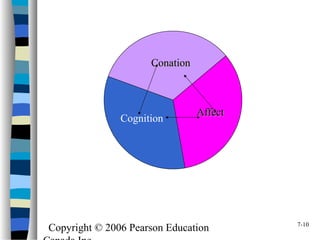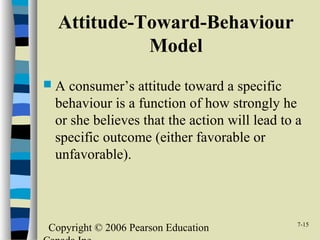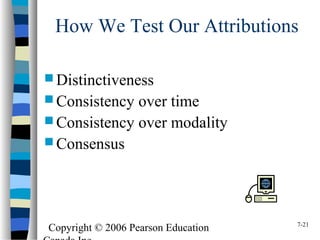Schiff cb ce_07
- 1. Chapter 7 Consumer Attitude Formation and Change Consumer Behaviour Canadian Edition Schiffman/Kanuk/Das Copyright © 2006 Pearson Education Canada Inc.
- 2. Opening Vignette The impact of SARS on tourism - real risk was low, but perceived risk was high - led to negative attitude towards Canada, especially Toronto Attitude change through - value-expressive appeals - use of celebrities Copyright © 2006 Pearson Education 7-2
- 3. Attitudes A learned predisposition to behave in a consistently favorable or unfavorable manner with respect to a given object A positive attitude is generally a necessary, but not sufficient, condition for purchase – Mercedes seen as ‘top of class’ but intention to purchase was low Copyright © 2006 Pearson Education 7-3
- 4. Characteristics of Attitudes Attitudes have an “object” Attitudes are learned – Can ‘unlearn’ Attitudes have behavioural, evaluative and affective components – Predisposition to act – Overall evaluation – Positive or negative feelings » continued Copyright © 2006 Pearson Education 7-4
- 5. Characteristics of Attitudes Attitudes have consistency Attitudes have direction, degree, strength and centrality – – – – Positive or negative Extent of positive or negative feelings Strength of feelings Closeness to core cultural values Attitudes occur within a situation Copyright © 2006 Pearson Education 7-5
- 6. Four Basic Functions of Attitudes The Utilitarian Function – How well it performs The Ego-defensive Function – To protect one’s self-concept The Value-expressive Function – To convey one’s values and lifestyles The Knowledge Function – A way to gain knowledge Copyright © 2006 Pearson Education 7-6
- 7. How are attitudes learned? Classical conditioning - through past associations Operant conditioning - through trial and reinforcement Cognitive learning – through information processing – Cognitive dissonance theory – Attribution theory Copyright © 2006 Pearson Education 7-7
- 8. Attitude Models Structural Models of Attitudes – Tri-component Attitude Model – Multi-attribute Attitude Model – Both assume a rational model of human behaviour Other models of attitude formation – Cognitive dissonance model – Attribution theory Copyright © 2006 Pearson Education 7-8
- 9. The Tri-component Model Cognitive Component – knowledge and perceptions acquired – through direct experience and information from various sources. Affective component – Emotions and feelings about the object Conative or Behavioural Component – Action tendencies toward the object Copyright © 2006 Pearson Education 7-9
- 10. Conation Cognition Affect Copyright © 2006 Pearson Education 7-10
- 11. Multi-attribute Attitude Models Attitude models that examine the composition of consumer attitudes in terms of selected product attributes or beliefs. Examples – Attitude-toward-object Model – Attitude-toward-behaviour Model – Theory-of-Reasoned-Action Model Copyright © 2006 Pearson Education 7-11
- 12. Attitude-toward-object model Attitude is function of evaluation of product-specific beliefs and evaluations n – Ao= WiXib i=1 – Where: Ao= Attitude towards the object O Wi = importance of attribute i Xib = belief that brand b has a certain level of attribute I continued Copyright © 2006 Pearson Education 7-12
- 13. Theory of Reasoned Action – A comprehensive theory of the interrelationship among attitudes, intentions, and behaviour Copyright © 2006 Pearson Education 7-13
- 14. Copyright © 2006 Pearson Education 7-14
- 15. Attitude-Toward-Behaviour Model A consumer’s attitude toward a specific behaviour is a function of how strongly he or she believes that the action will lead to a specific outcome (either favorable or unfavorable). Copyright © 2006 Pearson Education 7-15
- 16. Cognitive Dissonance Theory Holds that discomfort or dissonance occurs when a consumer holds conflicting thoughts about a belief or an attitude object. Post-purchase Dissonance – Cognitive dissonance that occurs after a consumer has made a purchase commitment Copyright © 2006 Pearson Education 7-16
- 17. Why Might Behaviour Precede Attitude Formation? Cognitive Dissonance Theory Attribution Theory Behave (Purchase) Form Attitude Copyright © 2006 Pearson Education Form Attitude 7-17
- 18. Attribution Theory Examines how people assign casualty to events and form or alter their attitudes as an outcome of assessing their own or other people’s behaviour. Examples – Self-perception Theory – Attribution toward others Copyright © 2006 Pearson Education 7-18
- 19. Self-Perception Theory Attitudes developed by reflecting on their own behaviour Judgments about own behaviour Internal and external attributions » Continued Copyright © 2006 Pearson Education 7-19
- 20. Self-Perception Theory Consumers are likely to accept credit for successful outcomes (internal attribution) and to blame other persons or products for failure (external attribution). Foot-In-The-Door Technique Copyright © 2006 Pearson Education 7-20
- 21. How We Test Our Attributions Distinctiveness Consistency over time Consistency over modality Consensus Copyright © 2006 Pearson Education 7-21
- 22. Attitudes and Marketing Strategy Appeal to motivational functions of attitudes Associate product with a special group, cause or event Resolve conflicts among attitudes Influence consumer attributions » Continued Copyright © 2006 Pearson Education 7-22
- 23. Attitudes and Marketing Strategy Alter – – – – components of the attitude Change relative evaluation of attributes Change brand beliefs Add an attribute Change overall brand evaluation Change beliefs about competitors’ brands » Continued Copyright © 2006 Pearson Education 7-23
- 24. Attitudes and Marketing Strategy Change affect first through classical conditioning Change behaviour first through operant conditioning Copyright © 2006 Pearson Education 7-24
























